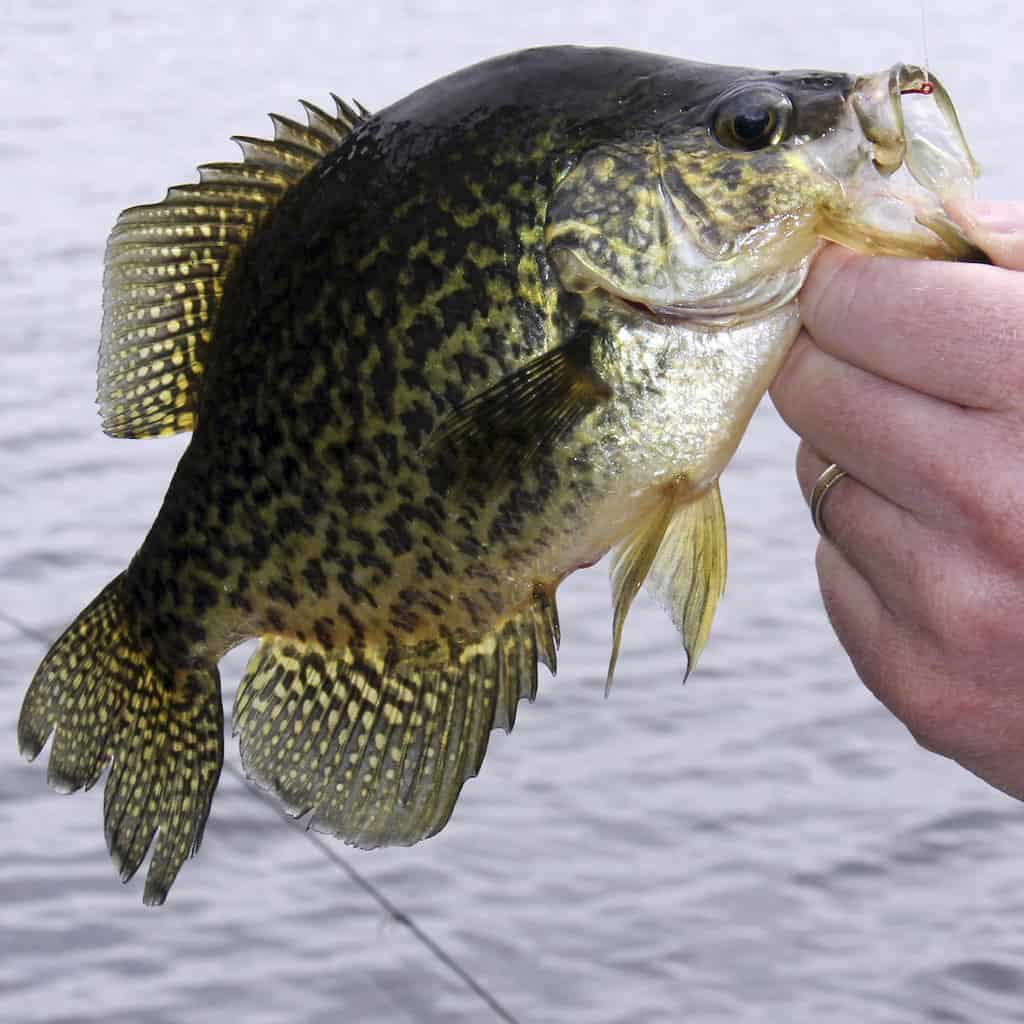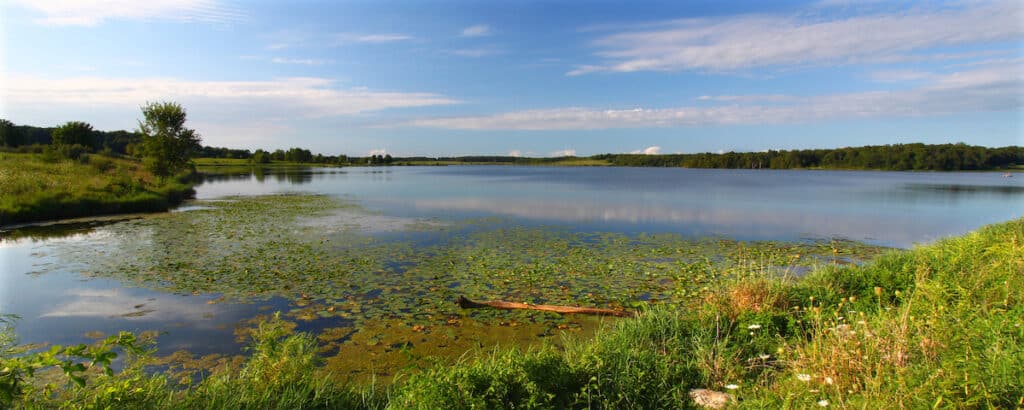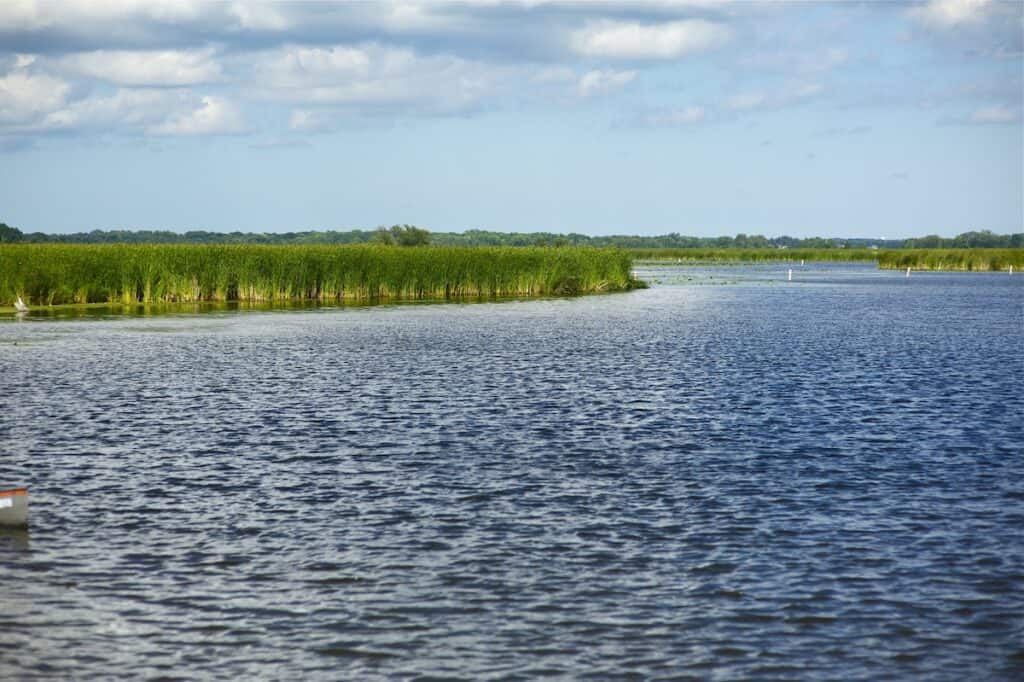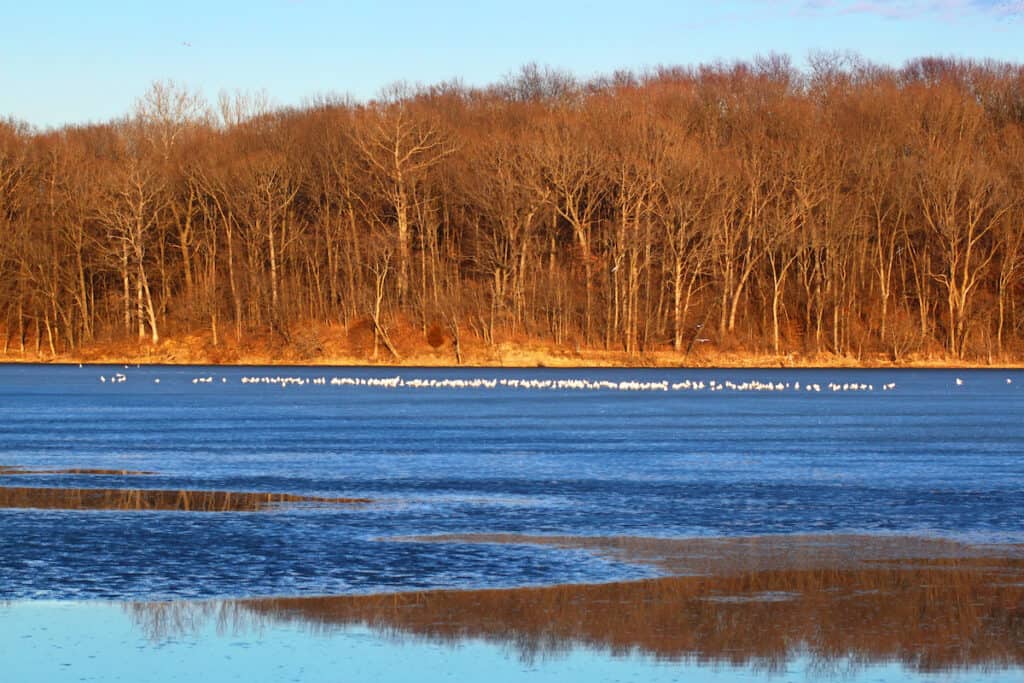Crappies are some of the most popular game fish among Prairie State anglers, and it’s not hard to see why. There’s a strong case to be made that Illinois is the best state for crappie fishing in the Midwest.
Many of the best crappie lakes in Illinois are clustered together at the southern end of the state. The Downstate area has an abundance of large, fertile reservoirs where crappies thrive.
But there are also outstanding crappie options in every part of the state, from the power plant cooling impoundments in Central Illinois to Northern Illinois’ natural glacial lakes. And don’t forget about big river-dwelling crappies.
Black crappies and white crappies are both abundant in many Illinois waters. Spring is generally the best time to catch them, and quite a few areas are known to produce crappies weighing 3 pounds or more.
Rend Lake
It’s impossible to talk about crappie fishing in Illinois without talking about Rend Lake, an 18,900-acre reservoir in the southern part of the state with a longstanding reputation as one of the top crappie lakes in the Midwest.
Fishing starts early here, and crappies often turn on as early as February, especially if there’s a good string of 50-degree days to wake them up. Focus on deep-ish structure adjacent to northern shorelines this time of year.
The period from late winter into early spring is prime time to fish for crappies around sunken cribs and brush piles, of which Rend Lake has many. The DNR has sunk Christmas tree cribs marked with white buoys, but anglers have placed even more structures.
The areas right around the State Route 154 bridges are some of the best places to target crappies in spring. Huge fish schools are usually within a few hundred yards of the bridges.
By late April, crappies should be shifting into spawn mode, and the peak of the spawn is usually during the first week or two of May.
Rend Lake has a ton of buck brush along its shorelines, and anglers will find crappies in and around the brush, often right up against the banks.
The Gun Creek Arm of Rend Lake is one of the best areas to catch crappies during the spawn. Using long 10-foot poles to “dip” minnows and jigs into the brush is a popular tactic that can produce non-stop bites in early May.
It’s also worth noting that Rend Lake gets intense fishing pressure, and the crappie fishery has had its ups and downs. Recent DNR surveys indicate that it’s more of a numbers lake than a slab factory these days, with lots of 9- to 11-inch crappies but relatively few in the 12+ inch class.
But given the cyclical nature of crappie populations, this could change at any time. Considering the population’s size and the abundance of spawning habitat, you should never write off Rend Lake.
Numerous launch sites are available around Rend Lake. Wayne Fitzgerrell State Recreation Area offers camping, bank fishing, and launch facilities convenient to Gun Creek and the 154 Bridges.
More: Complete Guide to Rend Lake Fishing
Lake Shelbyville
A flood control impoundment on the Kaskaskia River, Lake Shelbyville is a great crappie lake in South-Central Illinois. Black and white crappies are both abundant in this 11,100-acre reservoir.
Quite a few of these fish measure 15 inches and weigh 2 pounds. The crappie spawn works a little differently here, due in large part to the fact that the Corps of Engineers draws Lake Shelbyville down considerably in winter.
Crappies in Lake Shelbyville start to spawn around mid-April most years, as soon as water temperatures hit the mid-50s and the levels have risen enough for fish to access quality spawning cover.
The action picks up first at the lake’s northern end, where the water warms fastest in the springtime because it is shallower and more turbid. The area around Wilborn Creek Recreation Area is often the first place to turn on.
From then on, the spawn works its way south along the lakeshore, and anglers should do the same, hitting every little creek and cove with downed trees and flooded brush.
Crappie anglers tend to do most of their fishing around the time of the spring spawn, but Lake Shelbyville is also one of Illinois’ best summer crappie lakes. Crappie are relatively unpressured this time of year.
By July, a thermocline usually sets up between 15 and 20 feet below the surface of Lake Shelbyville. Crappies will school together as close to that line as they can for comfort. Any brush pile in that depth range has the potential to be loaded with crappies through August.
Crappie anglers are also likely to tie into some white bass, as Lake Shelbyville is among the best sand bass spots in Illinois.
Lake of Egypt
With waters warmed by the power plant on its northern shore, Lake Egypt is one of the best winter crappie lakes in Illinois and one of the first places in the state to start seeing spawning action every spring.
A 2,400-acre Downstate Lake built to supply cooling water to the Lake of Egypt Power Plant, Lake of Egypt is known for both numbers and size when it comes to crappies. Anglers catch lots of 2-pounders here every year.
During January and February, look for crappies stacked up over brush and woody cover about 20 feet down. As the lake warms, crappies transition toward shallow vegetation, which is quite abundant here.
The power plant is next to the dam at the lower (i.e. northern) end of the lake, and the coves and bays nearby are the first places to warm in early spring. Look for crappies in 5 to 7 feet of water during pre-spawn as they follow the creek channels toward shallow water.
Lake of Egypt has numerous coves, and many of them are loaded with great crappie cover. Grass beds, docks and boathouses, brush piles and rocky areas can all produce in springtime.
Egyptian Hills Cove has some sunken remnants of an old roadbed and bridge that often holds crappies (as well as some giant catfish), and nearby Eagle Point Bay and Bethlehem Bay can also be excellent at times.
Southern Illinois Power Cooperative owns Lake of Egypt. Although the entire lake is open to the public for fishing, it has no designated public access sites. However, several private marinas offer launch facilities.
Shabbona Lake
Northern Illinois doesn’t have quite the crappie fishing that the southern part of the state does, but Shabbona Lake does a lot to prove that perception wrong. A little over 90 minutes west of Chicago, Shabbona Lake offers a great fishery in which black crappies are most common.
Crappies in Shabbona Lake have a reputation for their excellent growth rate, so expect to catch healthy fish in every size range. The lake also has diverse habitat, including weeds, brush piles, old roadbeds, and even flooded farm buildings inundated when this reservoir filled.
Perhaps most importantly, the lake is also loaded with standing timber in both deep and shallow water. These sunken trees are some of Shabbona Lake’s best crappie cover, especially early in the season.
When the water is warming up toward the 50-degree mark in spring, crappies move into the timber at depths of around 30 feet. They tend to suspend just a few feet off the bottom, and the best presentation is a live minnow on a small Aberdeen hook beneath a slip float.
As the lake warms up, crappies will inch toward shallower water, usually relating to timber and sunken cribs as they gradually approach spawning areas. May is the best time to target crappies with tubes and other small jigs in 5 feet of water or less.
Shabbona Lake is a fairly small lake at 316 acres, which makes it relatively easy to pattern.
Shabbona Lake State Recreation Area surrounds the shoreline, and quite a few timber areas and cribs are within casting distance of the “land piers” constructed along the banks.
Shabbona Lake also freezes over most years and provides some of the best ice fishing for crappies in Illinois.
This is also one of Illinois’ best muskie lakes, so don’t be too surprised if something bigger and toothier takes your bait.
More: Complete Guide to Shabbona Lake Fishing
Crab Orchard Lake
Crab Orchard Lake is a standout crappie lake in a region of Southern Illinois that is positively littered with great crappie lakes. Lake of Egypt is less than 10 miles to the south, and Rend Lake is just over 25 miles north, but don’t overlook Crab Orchard.
Broad, fertile and mostly shallow, Crab Orchard Lake spans about 6,900 acres and is quick to warm in springtime. March is the first good month to target crappies during a typical year, but the fishing can be excellent as late as June.
The lake is part of Crab Orchard National Wildlife Refuge, so there is little development around the shoreline. What it does have is a lot of riprap, which was placed along the banks to slow erosion.
When you see riprap on the banks, it’s a safe bet that it continues for some distance beneath the surface. Crappies often relate to wood and brush here just like they do everywhere, but some of the most successful local anglers key in on riprap.
The riprap along Route 148 (one of several bridges that span the lake) is among the best areas to catch crappies as they inch toward spawning grounds. Use jigs in bright colors like chartreuse to grab crappies’ attention in these stained waters.
In March, crappies will ebb and flow between deep and shallow areas depending on the weather, sometimes being caught in mere inches of water on warm days.
Brush piles and stake beds have been sunk all over Crab Orchard Lake, offering plenty of options in deeper water.
Black crappies are slightly more common than white crappies in Crab Orchard Lake, but white crappies tend to be larger. Expect to catch a lot of healthy 12- to 14-inch fish.
Mississippi River (Pool 13)
Illinois has 575 miles of river frontage along the Mississippi River—that’s more than any other state—which forms its entire western border. Though the Mississippi is most often associated with catfish, it offers incredible fishing for a range of species, including crappies.
Some of the biggest crappies in Illinois are pulled from backwaters and sloughs along the Mississippi River every spring. Many of these areas are loaded with stumps, brush, flooded trees, and other prime crappie cover.
The river is controlled by a series of locks and dams, and just about every pool has excellent crappie options. For the sake of simplicity, let’s focus on what is generally considered to be the best: Pool 13.
Pool 13 of the Mississippi River stretches about 34 miles from Lock & Dam 12 near Bellevue, Iowa, down to Lock & Dam 13 near Fulton, Illinois. As in every pool, the most turbulent area is the tailwater at the upper end, but the lower end of the pool is almost lake-like.
Some of the best crappie fishing is in and around Spring Lake, a broad, marshy backwater loaded with trees and brush on the Illinois side.
Big Slough Recreation Area has a public boat ramp right at the southern end of Spring Lake, and there are many bank fishing spots off State Route 84.
A little farther north, Mississippi Palisades State Park overlooks a spectacular maze of backwaters, including Buffalo Lake and Hickory Slough, where the spring crappie fishing is often phenomenal.
Camping, bank fishing and boat launch facilities are available in the park.
Fox Chain O’ Lakes
Located within spitting distance of the Wisconsin border, the Fox Chain O’ Lakes are some of the northernmost lakes in Illinois. They’re among the few natural lakes in the state attributed to ancient glaciers.
The Fox Chain comprises nine major lakes (and several smaller ones) that span about 7,100 acres. A series of channels connects them. They’re probably best known for being some of Illinois’ best walleye lakes, but crappie fishing is also off the charts, particularly in springtime.
Spring patterns start to take shape almost immediately after ice-out in March, and the fishing is usually excellent right through the spawn, which might not happen until May. Early on, the warmest shallows will consistently attract crappies.
There are a lot of reliable hot spots within these lakes, with some of the best crappie fishing taking place in and around the channels between the lakes. Crappies commonly relate to rocks and docks, as well as shallow brush and new vegetation.
Channels off the east and west sides on Channel Lake are great spring spots, along with the backwater between lakes Channel and Marie. Dunn’s and Spring lakes have some great spots too.
Chain O’ Lakes State Park provides bank and boat access.
Peak crappie and walleye fishing tend to coincide in springtime, so expect a mixed catch, especially if you’re fishing with live minnows. The best walleye bite is often right before dawn, and the best crappie bite is right after.
Clinton Lake
A long, narrow V-shaped reservoir in DeWitt County, Clinton Lake offers some of the best crappie fishing in Central Illinois. This power plant cooling reservoir produces predominantly white crappies, though your catch may include black crappies too.
Anglers catch lots of chunky 1-pound specimens of both species from Clinton Lake, along with a few that are considerably larger. The warm water discharge is the secret to fishing this reservoir, and it plays a large role in shaping crappies’ behavior.
The Clinton Power Station pumps warm water into the South Fork of Clinton Lake, keeping it warmer than most Central Illinois lakes all winter. The lake also warms up quickly in springtime, triggering an early spawn and making the lake less susceptible to the effects of passing cold fronts.
Crappies bite readily around timber and brush in March, and the fish usually start spawning by early April. There’s also great fishing a little later in the North Fork, which gives the lake an extended season overall.
Downed trees along the shore provide spawning habitat, as do cribs and brush sunk at various depths. There are also several riprap-lined bridge crossings over the South Fork, which attract crappies in both spring and fall.
Much of Clinton Lake’s shoreline is undeveloped, with several public boat launch and fishing access sites. Clinton Lake State Recreation Area offers camping as well as bank and boat access.
Kinkaid Lake
A sprawling Southern Illinois impoundment with dozens of finger-like coves, Kinkaid Lake encompasses 2,750 acres. At various times over the years, Kinkaid Lake has been a numbers lake and a trophy crappie lake as populations have gone through natural boom-and-bust cycles.
This was also a sleeper lake until 2017, when a new state-record crappie was caught here. That fish, which weighed 4.55 pounds and measured just over 18 inches, was determined to be a hybrid between black and white crappie.
Brush piles in the 8- to 15-foot range are good places to start early in the year, as crappies wake up and get ready to make their way toward the shallows. There’s also timber in the backs of many coves that draw in crappies.
Shad are a big part of crappies’ forage in Kinkaid Lake, and anglers often catch the biggest crappies on live shad. Try suspending a shad beneath a slip float around trees and brush.
While many anglers give up on crappies during the warmer months, Kinkaid Lake also has some reliable summer patterns.
Crappies seek out the shade of dense vegetation during the warmest time of year, and the edges of milfoil beds at 6- to 15-foot depths are productive, especially weed beds that coincide with a main lake point.
Kinkaid Lake State Fish & Wildlife Area surrounds the reservoir and includes several smaller recreation areas around the lakeshore. Campgrounds, fishing piers, and half a dozen boat launch sites are available.
Sangchris Lake
Anglers have been catching some nice crappies from 2,321-acre Sangchris Lake in recent years. This reservoir just outside Springfield has been an up-and-coming crappie lake for some time and is finally coming into its own.
Much like Clinton Lake—another Central Illinois reservoir just over an hour’s drive away—Sangchris Lake is a power plant cooling lake. And just like Clinton Lake, the power plant operation drives some of the major fishing patterns here.
When the plant is running, warm water discharges into the middle fork of Sangchris Lake’s three major forks. There is often excellent winter crappie fishing around deep brush piles and cribs in this arm. Try fishing the brush with a minnow on a drop-shot rig.
Crappies usually spawn in April, and they have no shortage of cover in which to do so. The shoreline is almost entirely undeveloped, and numerous laydown trees along the banks provide cover during the spawn.
Keep an eye out for the dead stems of last year’s lily pads in spring. These areas often attract a lot of crappies in springtime, as they tend to have dark bottoms that warm up fast.
Sangchris Lake offers both white and black crappies, with increasing numbers of both species over 12 inches.
Sangchris is also one of a handful of Illinois lakes offering “black nose” crappie, a particular strain of black crappie originating in Arkansas.
Sangchris Lake State Park surrounds the entire reservoir and provides an abundance of easy access. The park offers multiple boat launch sites, fishing piers, and bank fishing spots, and camping is also available.
The same factors that make Sangchris Lake excellent for crappie also have turned it into one of Illinois’ better bass fishing lakes.
Catch More Crappie
New to catching one of America’s favorite panfish? Time to read our simple guide to crappie fishing techniques and tips, including top lures and baits.




